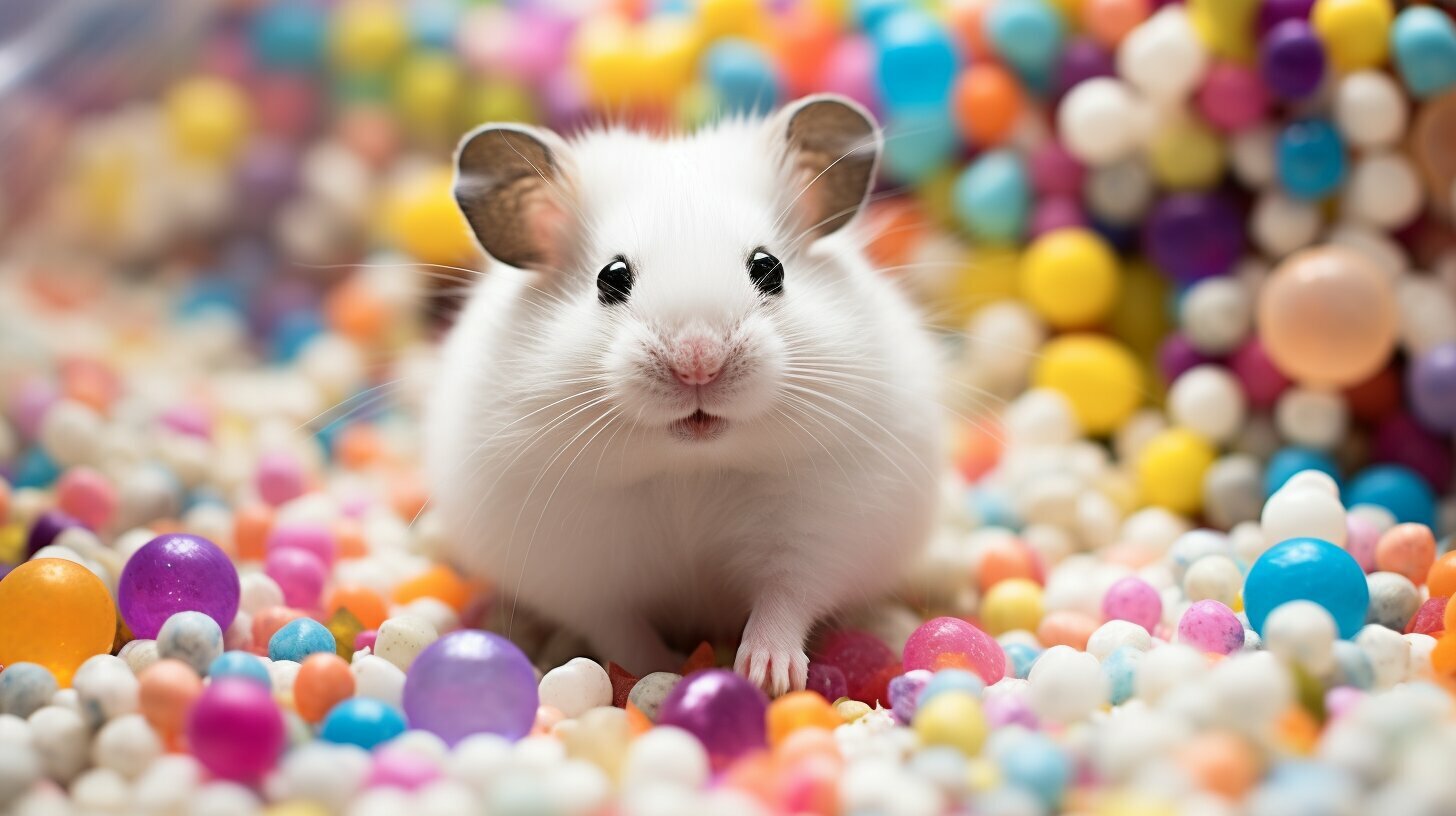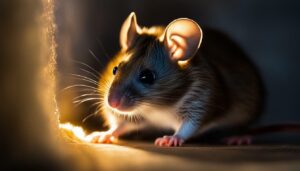Hamster enthusiasts often wonder about the rarity of white hamsters and the factors that determine their unique coloring.
While white hamsters as a whole are not necessarily rare, true albino hamsters, with their white fur and pink or red eyes, are quite rare due to a genetic mutation that reduces melanin production.
There are different ways for hamsters to have white fur, including genetic variations such as the dominant spotting gene, the acromelanic gene, the white-bellied gene, and complete albinism.
White hamsters with flesh-colored ears and black eyes are known as black-eyed whites, while white hamsters with dark ears and dark eyes are called dark-eared whites.
Albino hamsters, specifically Campbell’s Dwarf hamsters, have white fur, pink ears, and pink eyes. These true albino hamsters require special care due to potential vision impairments and sensitivity to sunlight.
Despite their rarity, albino hamsters have a similar lifespan to other hamster breeds, averaging around 2 years.
To ensure their well-being, albino hamsters should be provided with a proper cage, nutritious food, fresh water, and plenty of interaction and care.
While they can make good pets, handling should be done carefully due to their light sensitivity.
Key Takeaways:
- True albino hamsters with white fur and pink or red eyes are quite rare.
- White hamsters can have different genetic variations, including the dominant spotting gene, the acromelanic gene, the white-bellied gene, and complete albinism.
- Black-eyed whites have flesh-colored ears and black eyes, while dark-eared whites have dark ears and dark eyes.
- Albino hamsters, specifically Campbell’s Dwarf hamsters, require special care due to potential vision impairments and sensitivity to sunlight.
- Albino hamsters have a similar lifespan to other hamster breeds, averaging around 2 years.
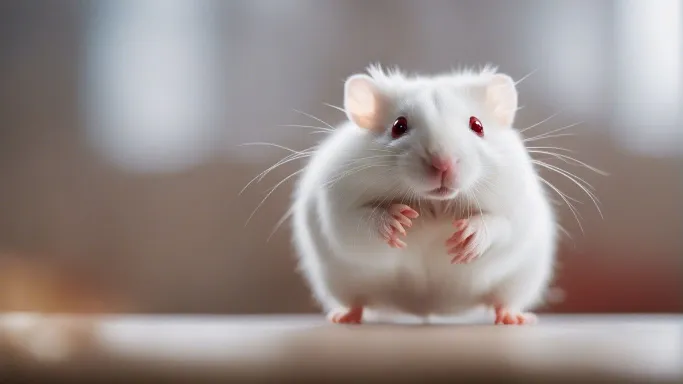
The Rarity of White Hamsters
Different hamster breeds exhibit varying levels of rarity when it comes to white fur, making them a sought-after choice among hamster enthusiasts.
White hamsters can be classified into different categories based on their genetic mutations. One type of white hamster is known as the black-eyed white, characterized by its white fur and black eyes.
Another variety is the dark-eared white, which has dark ears and dark eyes in addition to its white fur.
These unique colorations set white hamsters apart and contribute to their appeal in the hamster breeding community.
Albino hamsters, in particular, are extremely rare and highly sought after. These hamsters have a genetic mutation that reduces melanin production, resulting in their white fur and pink or red eyes.
Albino hamsters belong to the Campbell’s Dwarf hamster breed and have specific care requirements due to their susceptibility to light sensitivity and potential vision impairments.
While they have a similar lifespan to other hamster breeds, typically around 2 years, albino hamsters need to be provided with proper housing, a balanced diet, and regular interaction to ensure their well-being.
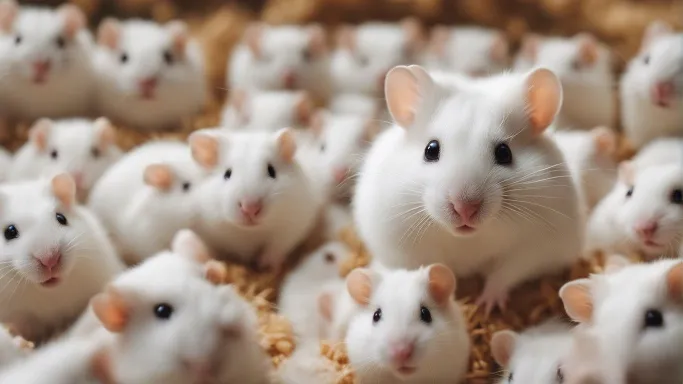
Understanding Albino Hamsters
Albino hamsters are unique not only in their appearance but also in their genetic makeup. They lack the pigment melanin, which gives their fur a white coloration.
This absence of melanin also affects their eye color, leading to the characteristic pink or red eyes. Albino hamsters are especially susceptible to sunlight and bright lights, as their lack of pigment makes their retinas more sensitive.
Therefore, it is crucial to provide them with a shaded and well-lit environment to protect their vision and prevent potential discomfort.
Due to their rarity and special care requirements, albino hamsters should only be handled with care.
It is important to approach them gently and avoid exposing them to bright lights, as excessive light can lead to vision problems.
Additionally, as with any hamster, regular handling and socialization are essential to establish trust and bond with your albino hamster.
By providing proper care and attention, albino hamsters can make delightful and beautiful pets for those willing to meet their unique needs.
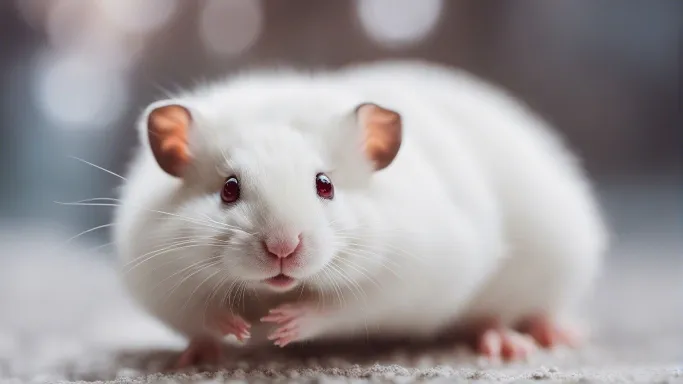
| Characteristics | Black-Eyed White Hamsters | Dark-Eared White Hamsters | Albino Hamsters |
|---|---|---|---|
| Fur Color | White | White | White |
| Eye Color | Black | Dark | Pink or Red |
| Ear Color | Flesh-colored | Dark | Pink |
In conclusion, white hamsters come in various rare forms, including black-eyed whites, dark-eared whites, and the particularly rare albino hamsters.
These unique color variants are captivating to hamster enthusiasts and require specific care to ensure their well-being.
By understanding their distinct characteristics and providing appropriate housing, nutrition, and handling, albino hamsters can thrive as cherished pets.
Understanding White Hamster Characteristics
White hamsters possess distinct traits that distinguish them from other hamster colors, making them an intriguing choice for prospective pet owners.
The main characteristic of white hamsters is, of course, their pristine white fur, which stands out amidst the array of hamster colors available.
This unique feature is attributed to various genetic mutations that affect the production of melanin, the pigment responsible for fur coloration.
There are several ways for hamsters to have white fur. One of the more common genetic mutations is the dominant spotting gene, which produces white patches on the hamster’s body.
Another mutation, known as the acromelanic gene, causes the hamster to have white fur with a pink or flesh-colored belly.
The white-bellied gene, as the name suggests, results in a white hamster with a white belly, while complete albinism is characterized by white fur, pale pink ears, and pink or red eyes.
It’s worth noting that within the category of white hamsters, there are different varieties that exhibit unique characteristics.
Black-eyed whites, for example, have white fur with black eyes and flesh-colored ears. On the other hand, dark-eared whites have white fur with dark ears and dark eyes.
These subtle differences in appearance add to the allure of white hamsters, as they offer a range of options for those seeking a visually striking pet.
Table: White Hamster Varieties
| Variety | Fur Color | Eye Color | Ear Color |
|---|---|---|---|
| Black-eyed White | White | Black | Flesh-colored |
| Dark-eared White | White | Dark | Dark |
In addition to their unique appearance, white hamsters are known for their friendly and sociable nature.
They can form strong bonds with their owners and enjoy interactive playtime. However, it’s important to provide them with proper care and attention.
This includes providing a suitable cage with ample space for exercise, a balanced diet consisting of pellets, fresh vegetables, and occasional treats, as well as regular handling and interaction to promote a healthy and happy bond between pet and owner.
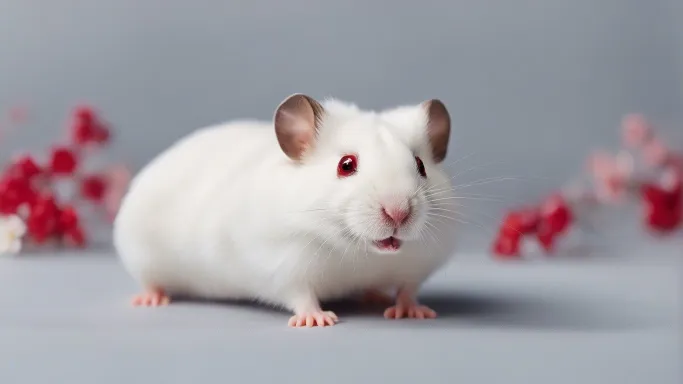
Differentiating White Hamster Varieties
There are various types of white hamsters, each with its own distinguishing features that make them stand out among other hamsters.
One popular variety is the black-eyed white. As the name suggests, these hamsters have white fur, black eyes, and flesh-colored ears.
They are known for their striking appearance and are often sought after by hamster enthusiasts.
Another unique type of white hamster is the dark-eared white. These hamsters have white fur, dark ears, and dark eyes.
The contrast between their white fur and the dark features gives them a distinct and eye-catching look.
Dark-eared whites are less common than black-eyed whites, making them even more desirable for breeders and collectors.
In addition to these two varieties, there are other genetic factors that can contribute to white fur in hamsters.
Some hamsters may have a dominant spotting gene, which causes patches of white fur on their bodies.
Others may have the acromelanic gene, which results in a white belly. And of course, there are the true albino hamsters with their completely white fur and pink or red eyes.
It’s important to note that while white hamsters may be visually stunning, their unique coloration does not affect their health or temperament.
Whether you choose a black-eyed white, dark-eared white, or any other variety of white hamster, you can expect a playful, curious, and loving pet.
Just keep in mind that albino hamsters require special care due to their sensitivity to sunlight and potential vision impairments.
| Variety | Fur Color | Eye Color | Ear Color |
|---|---|---|---|
| Black-eyed white | White | Black | Flesh-colored |
| Dark-eared white | White | Dark | Dark |
| Dominant spotting gene | White with patches | Varies | Varies |
| Acromelanic gene | White with white belly | Varies | Varies |
| Albino | Completely white | Pink or red | Pink or red |
Understanding Albino Hamsters
Albino hamsters, with their white fur and pink or red eyes, are rare specimens among hamster breeds, captivating animal enthusiasts worldwide.
These unique creatures possess a distinct genetic mutation that reduces melanin production, resulting in their characteristic appearance.
Unlike other hamsters with white fur, albino hamsters have a pink or red iris due to the absence of pigmentation in their eyes.
There are different ways for hamsters to have white fur, including the dominant spotting gene, the acromelanic gene, the white-bellied gene, and complete albinism.
White hamsters with flesh-colored ears and black eyes are known as black-eyed whites, while white hamsters with dark ears and dark eyes are called dark-eared whites.
However, albino hamsters, specifically Campbell’s Dwarf hamsters, stand out with their pure white fur, delicate pink ears, and striking pink eyes.
While these adorable creatures may be fascinating to observe, it’s important to note that albino hamsters require special care.
Due to their lack of pigmentation, their eyes are sensitive to sunlight, and they may experience vision impairments.
It’s crucial to provide them with a suitable cage that offers plenty of shade and protection from direct light.
Additionally, a balanced diet of high-quality hamster food, fresh water, and regular interaction and care are essential to ensure their well-being.
With proper care and attention, albino hamsters can make wonderful pets, bringing joy and companionship to their owners.
| Characteristics | Description |
|---|---|
| Fur Color | Pure white |
| Eye Color | Pink or red |
| Ears | Pink |
| Care Requirements | Special attention to light sensitivity, proper cage setup, nutritious food, fresh water, regular interaction |
| Lifespan | Average of 2 years |
Special Care for Albino Hamsters
Due to their unique genetic makeup, albino hamsters require specific care to ensure their well-being and comfort in a domestic environment. Albino hamsters have a genetic mutation that reduces melanin production, resulting in their white fur and pink or red eyes. This mutation can also lead to vision impairments and sensitivity to sunlight. To provide the best care for your albino hamster, it is important to consider their special needs.
One of the main considerations for albino hamsters is their sensitivity to light. Their lack of melanin makes their eyes more sensitive to bright light, which can be uncomfortable for them and potentially damaging to their vision. It is important to provide a suitable cage environment that offers adequate shade and minimizes exposure to direct sunlight. Placing the cage in a location away from direct sunlight and using low-intensity lighting in the room can help create a comfortable environment for your albino hamster.
In addition to light sensitivity, albino hamsters may also have vision impairments. Their pink or red eyes lack the pigmentation that filters out excessive light, which can make it harder for them to see clearly. Providing a cage setup with clear pathways and avoiding sudden changes in the environment can help minimize any potential visual challenges for your albino hamster. It is also important to handle them gently and avoid sudden movements to prevent any unnecessary stress or injury.
| Special Care Tips for Albino Hamsters: |
|---|
| Avoid exposing your albino hamster to direct sunlight. |
| Use low-intensity lighting in the room where the cage is located. |
| Create a cage setup with clear pathways and avoid sudden changes in the environment. |
| Handle your albino hamster gently and avoid sudden movements. |
By providing these special care considerations, you can help ensure that your albino hamster remains healthy, comfortable, and happy in its domestic environment. Regular vet check-ups are also recommended to monitor their overall well-being and address any potential health issues promptly. With proper care and attention, albino hamsters can make wonderful pets for those willing to meet their specific needs.
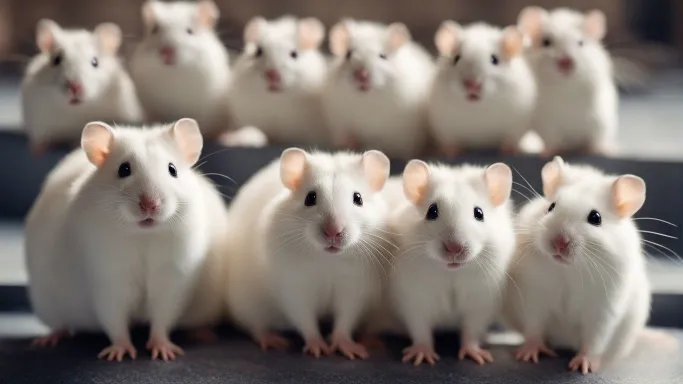
Lifespan and Maintenance of Albino Hamsters
Understanding the lifespan and taking proper care of albino hamsters is essential for providing them with a fulfilling and healthy life as pets. Albino hamsters, like other hamster breeds, have an average lifespan of about 2 years. However, it is important to note that individual hamsters may live slightly longer or shorter depending on their genetic predispositions, overall health, and the quality of care they receive.
When it comes to the maintenance of albino hamsters, providing a suitable cage is crucial. The cage should be spacious enough to allow them to move around comfortably and include suitable bedding material for burrowing. It is recommended to use a solid-bottomed cage, as wire mesh floors can potentially harm their delicate feet.
Albino hamsters also have specific dietary requirements. A balanced diet should consist of high-quality hamster pellets, supplemented with fresh vegetables, fruits, and occasional treats. Fresh water should always be available, and the water bottle should be checked and refilled regularly to ensure hydration.
Interaction and socialization are important aspects of caring for albino hamsters. They are social animals and should be provided with daily handling and playtime to promote mental stimulation and bond with their owners.
However, it is crucial to handle them gently and with care, as their sensitivity to light can cause discomfort and potentially vision impairments if exposed to bright sunlight or harsh artificial lighting.
| Aspect | Care Recommendation |
|---|---|
| Cage | Spacious cage with suitable bedding |
| Diet | High-quality hamster pellets, fresh vegetables, fruits, and occasional treats |
| Water | Always provide fresh water, regularly check and refill the water bottle |
| Interaction | Daily handling and playtime, gentle and careful handling |
Summary
Albino hamsters require proper care and attention to ensure their well-being. Understanding their lifespan and providing adequate maintenance, including a suitable cage, balanced diet, and regular interaction, is essential for their health and happiness.
Albino hamsters can make wonderful pets with the right care, but it is important to handle them gently and be mindful of their light sensitivity.
By following these guidelines, you can help your albino hamster live a fulfilling and healthy life as your beloved pet.
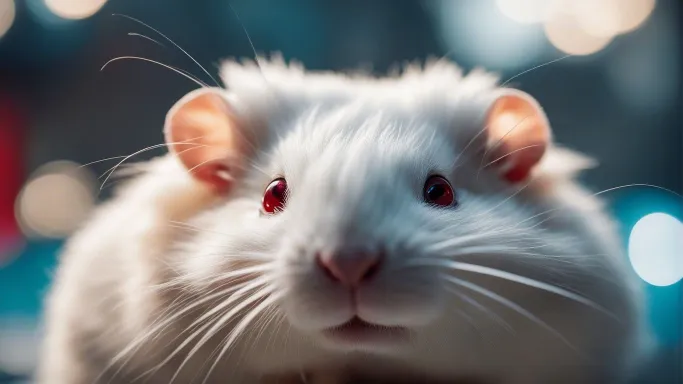
Albino Hamsters as Pets
Albino hamsters can make wonderful pets, but their unique needs and characteristics require prospective owners to be well-informed and prepared.
These adorable creatures, with their striking white fur and pink eyes, are a rare find in the hamster world.
Due to a genetic mutation that reduces melanin production, albino hamsters have a completely white coat that stands out from the usual hamster colors.
However, their stunning appearance comes with some specific care requirements that potential owners should be aware of.
When considering albino hamsters as pets, it’s crucial to understand their sensitivity to sunlight. Their pink or red eyes lack the pigmentation that protects them from harmful UV rays, making them particularly susceptible to sun damage.
As a result, it’s important to provide them with an enclosure that offers ample shade and minimizes exposure to direct sunlight.
Furthermore, albino hamsters may have vision impairments, so it’s essential to create an environment that accommodates their needs and minimizes potential hazards.
Proper nutrition is another crucial aspect of caring for albino hamsters. Ensuring they have a well-balanced diet that includes a variety of fresh fruits, vegetables, and commercial hamster food is vital.
Additionally, fresh water should always be available to keep them hydrated. Regular interaction and mental stimulation are also important for their well-being, as albino hamsters thrive with human companionship.
They can be social and enjoy interaction with their owners, so providing them with plenty of playtime and handling is essential for their happiness.
Albino Hamster Care at a Glance
| Aspect | Considerations |
|---|---|
| Enclosure | Provide a cage with plenty of hiding spots, bedding material, and areas for exploration. Ensure the cage protects them from direct sunlight. |
| Diet | Offer a balanced diet of fresh fruits, vegetables, and commercial hamster food. Consult a veterinarian for specific dietary recommendations. |
| Water | Supply fresh, clean water at all times and change it daily to ensure proper hydration. |
| Interaction | Provide daily playtime and handling to keep your albino hamster social and mentally stimulated. Be gentle with them due to their sensitivity to light. |
| Healthcare | Regularly check for any signs of illness or abnormal behavior. Schedule routine vet visits for vaccinations and health check-ups. |
By following these guidelines and dedicating time and effort to their care, albino hamsters can make delightful and rewarding pets.
Their unique appearance and endearing personalities make them a captivating addition to any hamster lover’s family.
However, it is essential to note that owning any pet comes with responsibilities, and prospective owners should educate themselves thoroughly before bringing an albino hamster into their home.
With the right knowledge and care, albino hamsters can thrive and bring joy to their human companions for years to come.
Considerations for Handling Albino Hamsters
Handling albino hamsters requires extra care and attention due to their unique sensitivity to light and potential vision challenges.
These hamsters lack pigmentation in their eyes, making them highly susceptible to damage from bright lights and sunlight.
It’s crucial to provide them with a suitable environment that minimizes exposure to direct sunlight and harsh lighting.
Placing their cage in a well-lit area but away from direct sunlight is recommended.
In addition to light sensitivity, albino hamsters may experience vision impairments, such as reduced visual acuity.
They rely heavily on their other senses, especially their sense of smell and touch. When handling an albino hamster, it’s essential to approach them gently and avoid sudden movements that could startle or stress them.
Always allow the hamster to become familiar with your scent by offering your hand for them to sniff before attempting to pick them up or interact with them.
It’s advisable to dim the lights in the room before handling an albino hamster to reduce the potential stress caused by bright lights.
A soft, ambient light source, such as a small desk lamp or a low-wattage bulb, can provide enough illumination without overwhelming their sensitive eyes.
By creating a calm and soothing environment, you can help alleviate any anxiety or discomfort that the hamster may experience during handling.
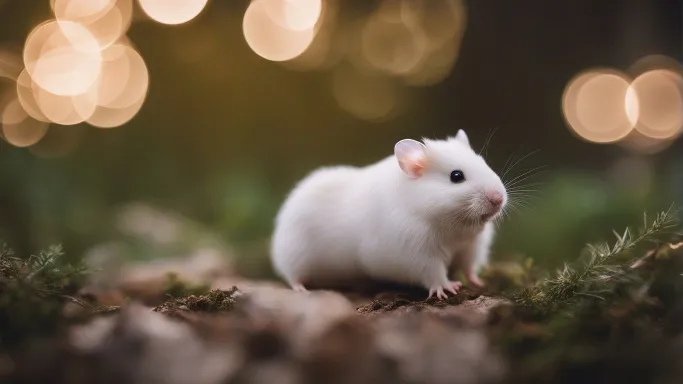
Precautions and Tips for Handling Albino Hamsters:
- Dim the lights in the room to reduce stress caused by bright lights
- Approach the hamster slowly and allow them to become familiar with your scent
- Avoid sudden movements that may startle or stress the hamster
- Provide a calm and soothing environment during handling
- Minimize exposure to direct sunlight and harsh lighting
- Always support the hamster’s body when lifting or carrying
By following these precautions and tips, you can ensure the safety and well-being of your albino hamster during handling. Remember, gentle and patient interactions are key to building trust with your hamster and creating a positive bond. With proper care and consideration, albino hamsters can make delightful and rewarding pets.
| Precautions for Handling Albino Hamsters | Tips for Gentle Handling |
|---|---|
| Dim the lights in the room | Approach the hamster slowly |
| Avoid sudden movements | Allow the hamster to become familiar with your scent |
| Minimize exposure to direct sunlight | Create a calm and soothing environment |
| Support the hamster’s body when lifting or carrying |
Conclusion
White and albino hamsters, though varying in rarity and care needs, offer a fascinating glimpse into the captivating world of hamster breeding and pet ownership.
True albino hamsters, characterized by their white fur and pink or red eyes, are quite rare. This unique coloration is a result of a genetic mutation that reduces melanin production.
Other ways for hamsters to have white fur include the dominant spotting gene, the acromelanic gene, the white-bellied gene, and complete albinism.
There are different varieties of white hamsters, such as black-eyed whites with flesh-colored ears and black eyes, or dark-eared whites with dark ears and dark eyes.
Albino hamsters, specifically Campbell’s Dwarf hamsters, have white fur, pink ears, and pink eyes.
While albino hamsters may require special care due to potential vision impairments and sensitivity to sunlight, they can make wonderful pets.
With a similar lifespan to other hamsters, about 2 years on average, albino hamsters need a proper cage, nutritious food, fresh water, and plenty of interaction and care.
It’s important to handle them with caution, considering their light sensitivity.
FAQ
Q: Are white hamsters considered rare?
A: White hamsters are not necessarily rare, but true albino hamsters with white fur and pink or red eyes are quite rare. There are different genetic mutations that can result in white fur in hamsters.
Q: What are the different ways hamsters can have white fur?
A: Hamsters can have white fur due to the dominant spotting gene, the acromelanic gene, the white-bellied gene, or complete albinism. These genetic mutations reduce melanin production, resulting in white fur.
Q: What are the different varieties of white hamsters?
A: White hamsters can be categorized into different varieties, including black-eyed whites with flesh-colored ears and black eyes, and dark-eared whites with dark ears and dark eyes.
Q: What are the characteristics of albino hamsters?
A: Albino hamsters, specifically Campbell’s Dwarf hamsters, have white fur, pink ears, and pink eyes. They are rare and may have vision impairments. They require special care and are sensitive to sunlight.
Q: What is the lifespan of albino hamsters?
A: Albino hamsters have a similar lifespan to other hamsters, about 2 years on average. Providing them with a proper cage, nutritious food, fresh water, and plenty of interaction and care can help ensure their well-being.
Q: Can albino hamsters be kept as pets?
A: Albino hamsters can be kept as pets, but they require special care due to their sensitivity to light and potential vision impairments. With proper care and handling, they can make good pets.
Q: Are there any precautions when handling albino hamsters?
A: When handling albino hamsters, it is important to be cautious of their light sensitivity. Avoid exposing them to direct sunlight and handle them gently to prevent any potential harm or stress.

